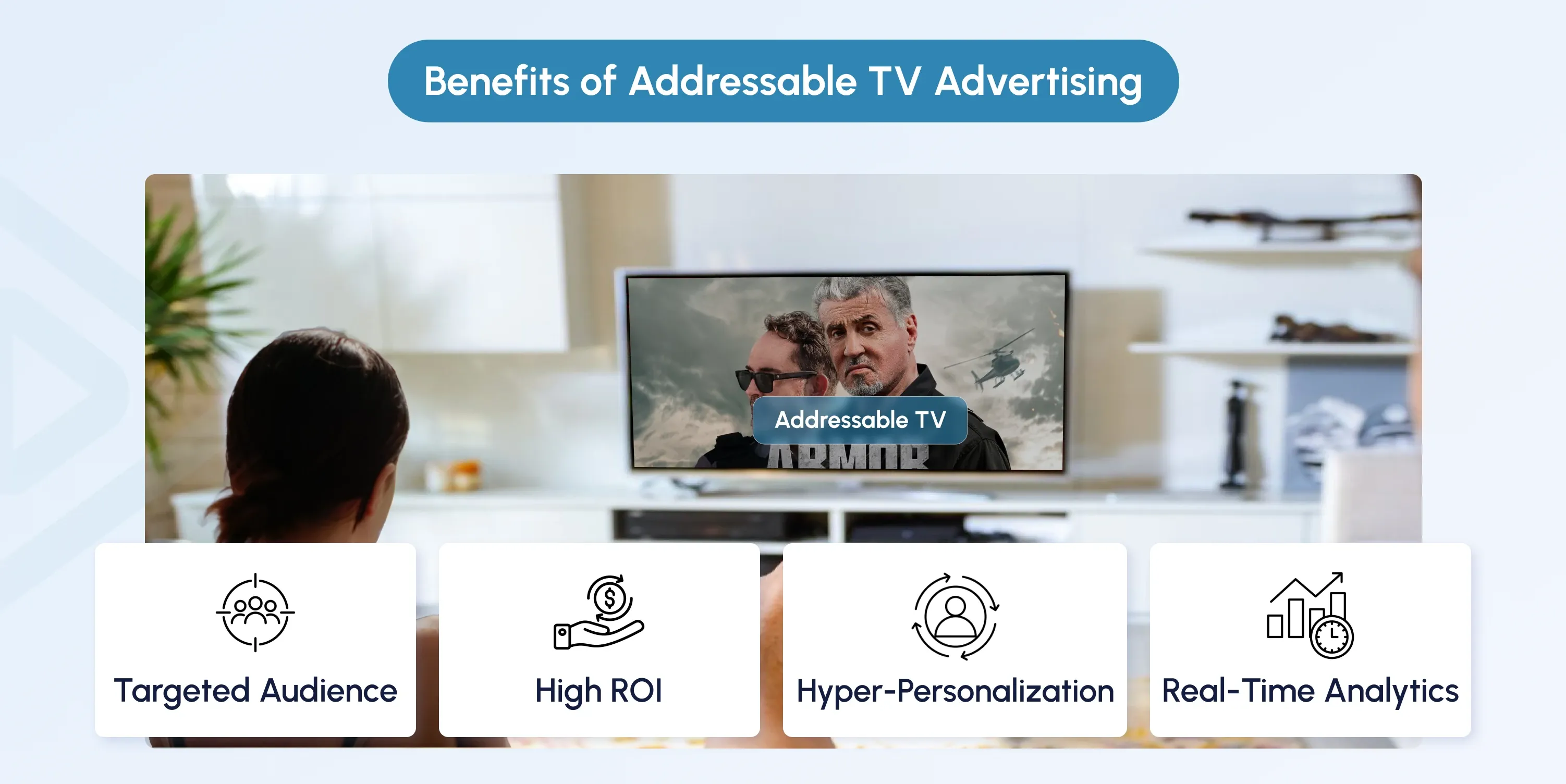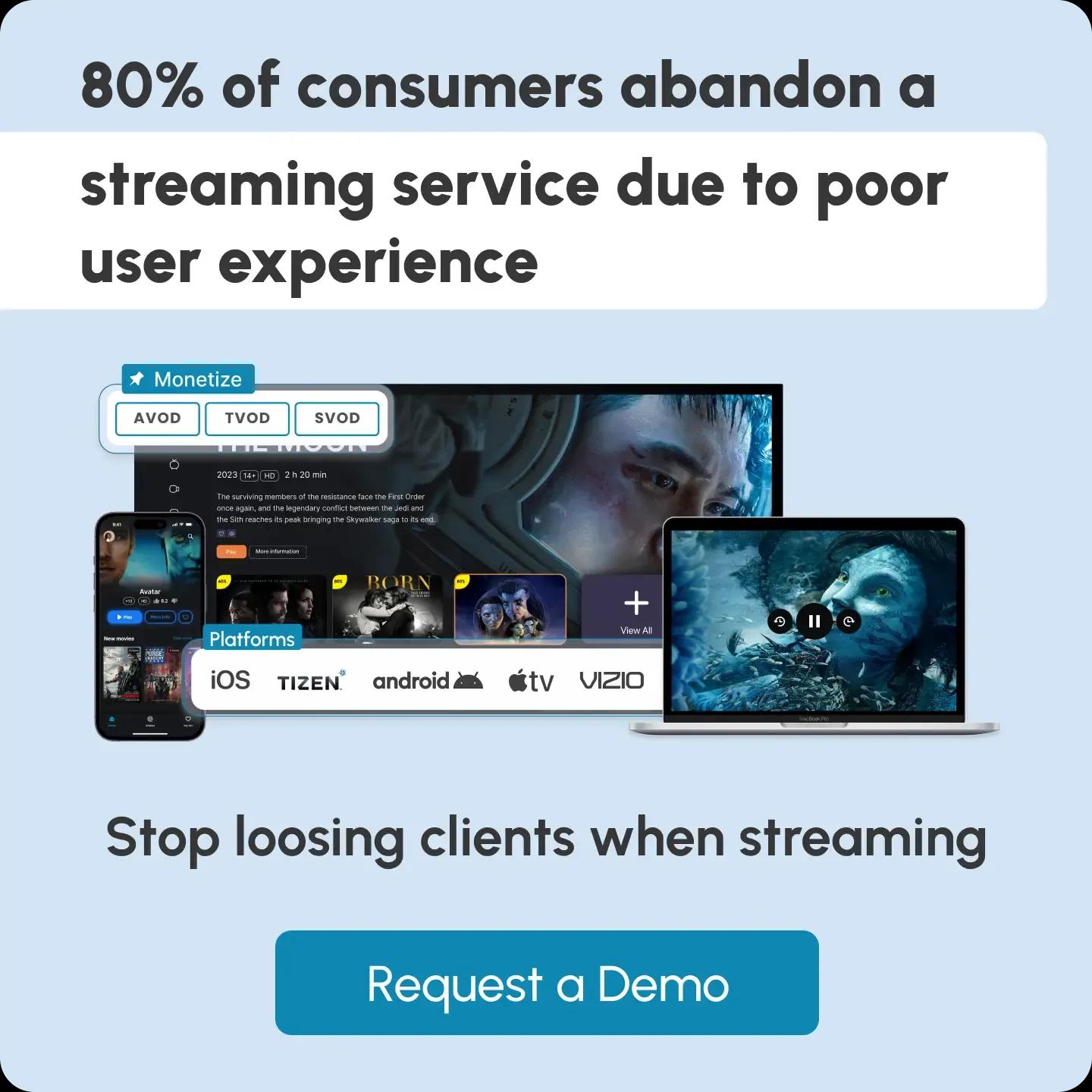
Addressable TV Advertising Explained: Benefits and Challenges
Imagine watching TV and seeing ads that actually interest you—no more irrelevant commercials.
That’s the power of addressable TV advertising!
Using data analytics and detailed targeting capabilities, addressable TV ads prepare custom ads for individual households or viewers according to their demographics, behaviors, and interests. For viewers, it means fewer generic ads and a more relevant, enjoyable experience.
This guide’ll explain how addressable TV ads work, their key benefits, challenges to consider, and what the future holds. Let’s dive in.

Key Takeaways
- Addressable TV advertising enables detailed targeting based on an individual's demographics, behavior, and needs, enhancing viewer engagement.
- Key benefits include a targeted audience, high ROI, personalization, and real-time analytics.
- The main challenges and considerations include audience segmentation, privacy concerns, high costs, and campaign complexity.
- Best practices for implementing addressable TV advertising involve setting clear goals, utilizing data effectively, choosing the right technology, and ensuring transparency.
What is Addressable TV Advertising?
The addressable TV advertising refers to a service that offers precision targeting by delivering personalized ads to specific households. It targets individuals using detailed demographic, behavioral, and interest data.
This approach allows brands to create hyper-personalized campaigns that deeply resonate with viewers, boosting engagement and conversion rates.
For example, a makeup artist watching a beauty tutorial show is far more likely to engage with an ad for lipstick than a sports fan watching a live football game.
Addressable TV ads differ from traditional TV advertising, which broadcasts a single ad to a broad audience, aiming for maximum reach and brand awareness. Addressable TV advertising ensures the right message reaches the right audience at the right time.
How Addressable TV Advertising Works
Addressable TV advertising uses data and technology to deliver personalized ads to specific households or individuals, rather than broadcasting to a general audience—no more one-size-fits-all commercials.
- This innovative approach begins with data collection from various sources, including viewer behavior, demographics, interests, and even purchase decisions. Such data typically comes from smart TVs, set-top boxes, or streaming services.
- Advertisers then use this data for audience segmentation, allowing them to tailor their messages to specific groups.
- Using addressable TV advertising technologies, ads are served in real time during live broadcasts, on-demand content, or streaming programs to predetermined audience segments.
This precision targeting is typically automated, allowing for real-time engagement and tracking of conversion metrics. Advertisers can optimize their campaigns in real time, enhancing effectiveness and return on investment (ROI).
4 Benefits of Addressable TV Advertising
Addressable TV advertising offers a range of compelling benefits that set it apart from traditional TV advertising. Here, we explore four key advantages:

1. Targeted Audience
Unlike traditional TV ads that cast a wide net, addressable TV ads let you reach viewers based on their location, interests, and behaviors. This targeted approach ensures your message reaches the most relevant audience, increasing the likelihood of engagement.
2. High ROI
Traditional TV ads often waste resources, as they reach a broad audience. Many consumers may not even be interested in the advertised product or service.
Addressable advertising focuses on prospective audiences more likely to be truly interested in the ad. As such, addressable TV advertising services maximize the return on investment (ROI) by targeting the right audience.
3. Hyper-Personalization
You can personalize addressable TV ads to the household level, making them more engaging for viewers. Personalized videos and ads resonate more with audiences, leading to increased engagement and higher conversion rates.
This level of customization helps brands build stronger connections with their target market.
4. Real-Time Analytics
Targeted TV advertising provides access to real-time analytics, allowing advertisers to monitor campaign performance closely.
This data-driven approach allows you to quickly adjust strategies and optimize your efforts based on real-time results. This advantage ensures that your campaigns remain effective and responsive to viewer behavior.
Benefits for OTT Platforms
OTT platforms must handle ad inventory management, technical integration, and scalability. Maintaining a seamless ad experience without disrupting content flow is key to success. That said, here are four key benefits of addressable ads for OTT platforms:
- Addressable ads command higher CPMs (cost per thousand impressions) than traditional TV ads.
- Delivering relevant, non-intrusive ads improves the viewer experience and reduces churn.
- Platforms can automate ad sales and optimize inventory for higher fill rates and revenue.
- Addressable TV ads work across smart TVs, streaming apps, and set-top boxes, reaching cord-cutters and traditional TV audiences alike.
Get Your Customized OTT Platform Here
Benefits for Viewers
Personalized ads also benefit viewers as follows:
- Instead of generic commercials, viewers see ads tailored to their interests, making the experience less intrusive.
- Addressable ads reduce ad fatigue, ensuring content remains engaging.
- Ad-supported models allow viewers to access premium content without a subscription fee.
- Some addressable TV ads offer clickable or shoppable features, creating a more engaging experience.
However, viewers may still find ad interruptions disruptive or have privacy concerns about data collection. Ensuring a balance between personalization and user experience should always be a priority for advertisers and OTT platform owners.
Addressable TV benefits everyone involved by delivering smarter, more relevant advertising. It boosts revenue for advertisers and platforms while improving the viewer experience.
Challenges and Considerations
Addressable TV Advertising Challenges for Advertisers
Addressable TV advertising allows for highly targeted campaigns, but advertisers must overcome a few notable challenges.
1. Audience Segmentation
One of the primary challenges in addressable TV advertising is effective audience segmentation. Ensuring that the targeted audience aligns perfectly with your campaign's goals is absolutely crucial for success. Advertisers must carefully analyze data to identify the right segments, which can be complex and resource-intensive.
Use AI-driven analytics and real-time data insights to refine audience groups continuously. A/B testing different segments can also help optimize targeting and improve ad relevance.
2. Privacy Concerns
Privacy concerns are another significant hurdle in addressable TV advertising. Collecting data for precise targeting may raise issues related to consumer privacy. Advertisers must adhere to strict regulations such as the General Data Protection Regulation (GDPR) and the American Data Privacy Protection Act (ADPPA) to mitigate these concerns, ensuring they collect and use the data responsibly.
3. High Costs
Addressable TV advertising can be more expensive than other forms of advertising, like social media ads, Google Ads, or traditional TV ads. The costs associated with data collection, technology, and partnerships can quickly add up! That’s why you need to consider your budget and expected ROI carefully.
To control costs, you can focus on high-value audience segments and leverage programmatic ad buying. Measuring ROI through real-time analytics is also a good idea to optimize your ad spend.
4. Complexity
Running an addressable TV ad campaign is a complex task that requires technical expertise and collaboration with multiple providers. The process can be time-consuming and resource-intensive, demanding careful planning and execution to achieve desired outcomes.
5. Ad Blockers and Opt-Outs
Some viewers may opt out of targeted advertising or use ad blockers, which can reduce the reach and engagement of addressable TV ads. Advertisers need to develop strategies to address these challenges and maintain audience engagement.
For example, you can complement your addressable TV ads with non-intrusive branded content, interactive ad formats, and special promotions to capture audience interest without relying solely on targeted ads.
Addressable TV Advertising vs. Traditional TV and OTT Ads
Addressable TV advertising uses data to deliver customized ads directly to specific households or individuals. This approach lets advertisers target viewers based on demographic, behavioral, and geographic data, utilizing set-top boxes, smart TVs, and sophisticated data analysis.
| Advertising Type | Description | Main Features | Best For |
|---|---|---|---|
| Addressable TV | Has the ability to track campaign performance with precision, offering valuable insights into viewer interactions. Although more expensive because of its advanced targeting capabilities, the return on investment (ROI) is often higher because the ads are more relevant to the audience. | - Precise campaign performance tracking - Advanced targeting capabilities - Higher ROI due to relevant ads | Advertisers seeking precise targeting and higher ROI |
| Traditional TV | Targets a broad audience, determined by the network and time slot in which the ads are placed. This method lacks the precision of addressable TV, as targeting is limited to general genres and unspecified audiences. | - Broad audience targeting - Limited precision - Relies on general viewership metrics | Advertisers aiming for a broad reach with lower costs |
| OTT | Offers a middle ground, enabling targeting based on digital behaviors and viewer profiles, similar to addressable TV. OTT's targeting capabilities depend on the data available from streaming platforms, which may not be as comprehensive as addressable ads. | - Digital behavior-based targeting - More affordable than traditional TV ads - Appeals to cord-cutters | Advertisers targeting digital audiences and cord-cutters |
At inoRain, we provide affordable and personalized OTT solutions, making it easier for you to scale up your advertising efforts. If you're looking to enhance your marketing efforts or build an audience, reach out to our specialists for world-class end-to-end OTT solutions tailored to your needs.
Best Practices for Implementing Addressable TV Advertising
Successfully implementing addressable TV advertising requires a blend of advanced technology and current consumer insights. This approach allows marketers to target ads effectively and track results with precision.
Here are the best practices to guide you:
Establish Clear Goals
Begin by setting well-defined campaign goals. Understanding your addressable media helps determine your objectives, which is crucial for deciding on your targeting and ad placements.
If you aim to increase brand awareness, drive conversions, or enhance customer retention, then align your strategy with these goals. Ensure your approach targets the right households and demographics to achieve your desired outcomes.
Use Data
Harness the power of data to refine who your addressable TV advertising is targeting. Use first-party data, such as customer purchase history and engagement metrics, to create specific audience segments.
To enhance targeting accuracy, incorporate third-party data sources, including demographic and behavioral information. Addressable TV allows for habitual and interest-based targeting, leading to more effective ad placements.
Choose the Right Technology
Use the latest technology to run your campaign efficiently. Choose the right platforms and partners to deliver addressable ads across various channels, including smart TVs, set-top boxes, and streaming platforms. Staying updated with technological advancements helps you maximize the impact of your advertising efforts.
Be Transparent
Transparency is vital in addressable TV advertising. Familiarize yourself with privacy regulations like GDPR and ADPPA to ensure compliance and protect individual data. Be open with your audience about how you use their data, and maintain secure and ethical data collection, storage, and usage practices. This transparency builds trust and enhances the effectiveness of your campaigns.
Future Trends in Addressable TV Advertising
With advancements in technology and shifts in consumer behavior, several key trends are shaping the future of addressable TV advertising. We explore five of them below.
Growing Audience
Connected TV (CTV) is emerging as one of the most promising channels in the advertising landscape. CTV's audience base is rapidly expanding, allowing advertisers to reach more viewers.
Increased Integration with Programmatic Advertising
Programmatic advertising has grown substantially because it can automate ad buying, enhance targeting efficiency, and optimize campaigns in real time. This trend is expected to continue, further integrating with addressable TV to streamline and improve advertising strategies.
AI-Driven Personalization
Addressable TV advertising is distinguished by its personalization capabilities. Artificial intelligence (AI) will play a crucial role in creating hyper-personalized ads based on real-time audience data and behavioral insights. It’ll only further enhance viewer engagement and campaign effectiveness.
Focus on First-Party Data
With increasing privacy concerns and restrictions on third-party data, advertisers will need to rely more on first-party data. This shift will ensure that campaigns remain personalized and effective without compromising consumer privacy.
Shoppable TV Ads
According to Statista, one in three viewers who watched an ad on CTV made a purchase in 2023. As CTV and digital video continue to grow, shoppable TV ads will become more prevalent, allowing viewers to buy products directly from their screens. This trend offers product owners a direct path to sales through engaging and interactive advertising.
Conclusion
Addressable TV advertising is changing how brands connect with their audiences by offering precision targeting and personalized ad experiences. Targeted reach, high ROI, and real-time analytics can significantly improve campaign effectiveness.
As future trends like AI-driven personalization and shoppable TV ads gain momentum, staying ahead of the curve is crucial for success.
FAQs
Can addressable TV ads be used in OTT and live-streaming environments?
Yes, addressable TV ads work seamlessly in OTT and live-streaming environments. They allow advertisers to deliver targeted ads based on viewers' preferences and behaviors, ensuring relevance and impact.
What types of data are used to target addressable TV ads?
Advertisers use demographic, geographic, behavioral, interest-based, and third-party data to personalize addressable TV ads effectively.
How does addressable advertising improve viewer experience?
By delivering relevant and personalized ads, addressable advertising engages viewers more effectively, increasing their interaction and satisfaction.
Are there any privacy concerns with addressable TV ads?
Yes, privacy is a key concern. Advertisers must ensure they have proper permissions to collect data and comply with regulations like GDPR and ADPPA to protect consumer trust.
Can addressable ads be combined with other monetization models?
Yes, addressable ads integrate well with models like subscription-based (SVOD), ad-supported (AVOD), and pay-per-view, offering flexibility for optimizing revenue strategies while delivering targeted content.
Co-founder / CTO
Armen is the CTO and Co-Founder of inoRain OTT and Co-Founder of HotelSmarters, specializing in advanced streaming technologies, OTT strategy, and interactive TV systems. He builds scalable end-to-end video delivery solutions and drives technical innovation across hospitality and streaming platforms, bridging complex engineering with practical business impact.

OTT Advertising: Types, Best Practices, and Strategies
Over-the-top (OTT) advertising has transformed how brands connect with consumers.

VPlayed Alternatives: inoRain vs. VPlayed
Explore inoRain as a VPlayed alternative, comparing features, pricing, and OTT solutions to find the best platform for your streaming needs.

Custom OTT Platform Development: How to Start an OTT Business
This guide will walk you through everything you need to know about the OTT platform development.

